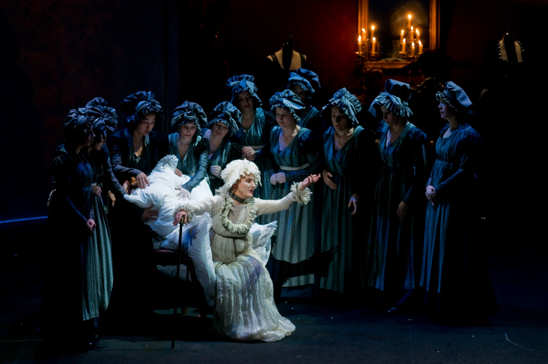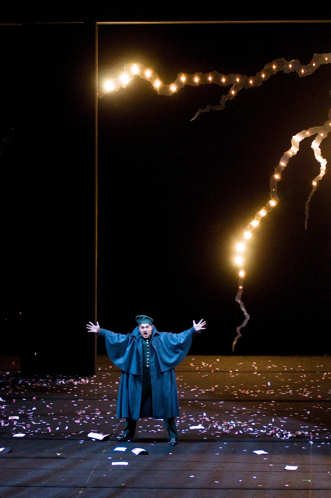Other Links
Editorial Board
- Editor - Bill Kenny
- London Editor-Melanie Eskenazi
- Founder - Len Mullenger
Google Site Search
SEEN
AND HEARD INTERNATIONAL OPERA REVIEW
Tchaikovski, La Dame de Pique:
new production, Peter Stein stage director: Soloists,
chorus. ballet and orchestra of the Opéra de Lyon, Kirill Petrenko
conductor. Lyon, France. 30.1.2008 (MM)
Suicide loomed large in Tchaikovsky's mind, with the two
emotionally charged, self-inflicted deaths in La Dame de Pique.
Suicidal in the opera also would have been the intended duel
between the competing lovers, a form of Russian self elimination
that had already claimed the life of Pushkin, the creator of the
original Pique Dame tale (1834). In one further case of
self destruction the phantasmagoric Pique Dame herself had to know
that she was buying death by accepting the secret of the cards.
Tchaikovsky's own suicide was in 1893, three years after the
opera's premiere at the Marinsky in St. Petersburg in 1890, and
nine days after the premiere of his Symphonie Pathetique
(though the Opéra de Lyon's program booklet attributes his death
to cholera, the cause condoned by Soviet era sensibilities).
Based in theatrically sophisticated Berlin, Peter Stein is a
master director, working with precise minimal movements to create
and sustain dramatic tension. Each motion -- a hand touching a
cheek or a slow (or fast) walk up or down stage for example -- is
charged with dramatic content and made always with absolute
complementary musical motivation. His choruses are a single
persona, not crowds, never individuals. The chorus is in
constant, generally geometric and unison movement, its energy
enhanced at times by moving scenic elements, always sustaining a
physical tension that heightens the sense of intense story
telling.
Others of her phantasmagoric guises of the third act echoed the
mock grotesqueries of the Mexican Day of the Dead or the American
Halloween (a custom now finding resonance in France as well).
Perhaps there is no Halloween in Russia or Protestant Germany,
thus maybe these were not meant to be the really silly apparitions
they seemed to be, but were serious grotesqueries, part of
designer Wogerbauer's cardboard vocabulary. Whatever the
motivation for the comic book language the powerful pathos and
intense ironies of the third act were blatantly destroyed. The
death prayer for the Countess' funeral was overwhelmed with scary
images, and the touching choral prayer for Hermann's final peace
seeming to be still in the shadow of the waving arms of an
inflatable Pique Dame seen only moments before.
Michael Milenski

Tchaikovsky's soul is the stuff of sensational speculation, and it
is enticing to transpose these speculations onto the tortured soul
of Hermann, the hero of Pique Dame, his consuming
compulsions tricked by vindictive Russian fate. In Lyon at the
Opéra Nouvel (30/01/08) this famous story was told by director
Peter Stein, his collaborators and an excellent array of
interpreters, notably his diminutive hero Hermann resembling
Pushkin's comparison to Napoleon far more than embodying the
handsome Tchaikovsky we see in photographs.
Bulgarian tenor Kostadin Andreev, singing Hermann this evening
(and only one other of the total seven performances), attacked the
role, physically possessed in staggering and lurching movements,
urgently voicing his distress. In short a theatrically and
musically intriguing introduction to the central figure, the
fateful lover and tragic victim of Modest and Peter Tchaikovsky's
Pique Dame (Tchaikovsky's brother Modest was the librettist
who, with Tchaikovsky, had transformed Pushkin's story into a
conventional Russian opera of its time). And tenor Andreev kept
us intrigued for the duration, elaborating this character born of
Carmen's clumsy Don Jose but quickly evolving into the
physically supple and vocally boiling-over lover of the gullible
Liza, though the nearly inhuman form of the diabolically possessed
gambler was never far beneath the surface. Finally this pathetic,
dying young soldier sent us running to the Pushkin tale to find
out where he got those 40,000 ducats to bet, a detail left
unexplained by the libretto. The daunting challenges of director
Peter Stein's approach to this role were well met by this young,
multi-dimensional artist.

Herr Stein's musical collaborator was Russian born, Vienna trained
Kirill Petrenko, willing to support Herr Stein's tensions at the
expense of neglecting the indulgent ironic pathos exuded by
Tchaikovsky's music. Mo. Petrenko further agreed to excise
Tchaikovsky's entire Pastoral and ballet thereby upsetting the
balance of the larger Modest and Piotr Tchaikovsky music-dramatic
structure, forcing Tchaikovsky's central scene into a single,
fast, dramatic crescendo to the fireworks accompanied mock
appearance of Catherine the Great as a huge, self moving puppet.
Designer Ferdinand Wogerbauer's visual language well supports Herr
Stein's obvious tensions, with minimal shapes and forced
perspectives in cardboard, comic book images like the light bulb
lighted lightening bolts, the snowy night cutout for Liza's
suicide, even the diamond shaped gambling table concocted platform
with Hermann's head dangling, dead, over its downstage point.
Ironic in the truncated Pastoral scene were the black and red
blocks of architect Jean Nouvel's theater echoed on the stage.
Tchaikovsky is the master of pastiche, juxtaposing for example in
the last scene a sad gambling song, a noisy drinking song and a
suicide. In the third scene he segues an art song duet with a sad
Russian ballad followed by a foot stomping folk song and finally a
torrid love scene. Amidst all the seven scenes he inserted a huge
pastoral, an eighteenth century intermezzo with ballet starring
Daphnis, Chloe and Pluto, as, after all, Pushkin had set his tale
in the Russia of Catherine the Great and that is what they did
then. But in place of introducing a bit of the more appropriate
Rameau, for example, Tchaikovsky recast Don Giovanni's
immortal ball scene, an homage to his beloved Mozart. In the
following scene Tchaikovskian musical philology regained its
purity when he resurrected of an aria from Gretry's Richard
Coeur-de-Lion (1784) for the Pique Dame Countess. It all
works as seamless theater and convincing operatic story telling
and this is Tchaikovsky's genius.
Tchaikovsky's insertion of the extended Rococo pastoral motivated
the cameo appearance by Catherine herself. By cutting the
pastorale, director Stein eschewed Tchaikovsky's intention (and
Pushkin's) to place the story at this earlier time, instead
forcing the scenographic crescendo to her apparition in the same
bustled silhouette as we had come to associate with the Pique
Dame. Then as one of her apparitions in the nightmare scene we
saw Pique Dame herself as a huge, self-moving puppet, like
Catherine the Great.
The Hermann of Kostadin Andreev convincingly established the core
of Tchaikovsky's melodrama, the Liza of Olga Guryakova eloquently
embodied the naiveté of a country girl, with simplicity and
elegance of voice from her doomed soul crouched against the edge
of the proscenium. Prince Yeletsky, Andrey Breus as her rejected
rich and handsome fiancé, was rich in voice, generous of spirit,
and appropriately pallid in the magnetic presence of Hermann. The
Countess of Marianna Tarasova was an ancient, ugly, and selfish
creature, a relic of such an ugly and selfish past, propped-up in
her chair humming Gretry's old tune. The Tomski of Nikolai
Putilin was strangely old, though on the same high level of all
supporting players.
The association of the Pique Dame with Catherine the Great remains
shrouded in mysterious recesses of Peter Stein's psyche.
Pictures © Opéra de Lyon
Back
to Top
Cumulative Index Page
